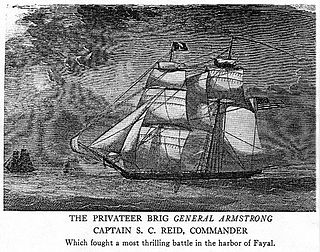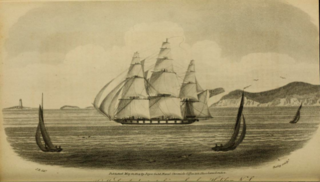
Nautilus was a schooner launched in 1799. The United States Navy purchased her in May 1803 and commissioned her USS Nautilus; she thus became the first ship to bear that name. She served in the First Barbary War. She was altered to a brigantine. The British captured Nautilus early in the War of 1812 and renamed her HMS Emulous. After her service with the Royal Navy, the Admiralty sold her in 1817.

HMS Fantome was an 18-gun brig-sloop of the Royal Navy. She was originally a French privateer brig named Fantôme, which the British captured in 1810 and commissioned into British service. Fantome saw extensive action in the War of 1812 until she was lost in a shipwreck at Prospect, Nova Scotia, near Halifax in 1814.
Liverpool Packet was originally the American slave ship Severn, built at Baltimore and captured in 1811. She became a privateer schooner from Liverpool, Nova Scotia, that captured 50 American vessels in the War of 1812. American privateers captured Liverpool Packet in 1813, but she failed to take any prizes during the four months before she was recaptured. She was repurchased by her original Nova Scotia owners and returned to raiding American commerce. Liverpool Packet was the most successful privateer vessel ever to sail out of a Canadian port.

HMS Poictiers was a 74-gun Royal Navy third rate. This ship of the line was launched on 9 December 1809 at Upnor. During the War of 1812 she was part of the blockade of the United States. She was broken up in 1857.
HMS Niemen was a Royal Navy 38-gun fifth-rate frigate. She began her career as the Niémen, a 44-gun French Navy Armide-class frigate, designed by Pierre Rolland. She was only in French service for a few months when in 1809 she encountered some British frigates. The British captured her and she continued in British service as Niemen. In British service she cruised in the Atlantic and North American waters, taking numerous small American prizes, some privateers but mostly merchantmen. She was broken up in 1815, at the end of the Napoleonic Wars and the War of 1812.
USS Rattlesnake was the brig Rambler built in Medford, Massachusetts, in 1812 that the United States Navy purchased in July 1813. Rattlesnake captured numerous British merchant vessels before HMS Leander captured her in mid-1814. The Royal Navy apparently purchased her at Nova Scotia, but there is no record of her subsequent career.
HMS Pictou was a 14-gun schooner that the Royal Navy captured in 1813. She served briefly on the Royal Navy's North American station, capturing one or two merchantmen before the American frigate USS Constitution captured her during the War of 1812.

HMS Spartan was a Royal Navy 38-gun fifth-rate frigate, launched at Rochester in 1806. During the Napoleonic Wars she was active in the Adriatic and in the Ionian Islands. She then moved to the American coast during the War of 1812, where she captured a number of small vessels, including a US Revenue Cutter and a privateer, the Dart. She then returned to the Mediterranean, where she remained for a few years. She went on to serve off the American coast again, and in the Caribbean, before being broken up in 1822.
HMS Anaconda was an 18-gun brig-sloop of the Royal Navy during the War of 1812. She was cruising as an American privateer until sailors from HMS Sceptre captured her in 1813. She served briefly in the Royal Navy during the later stages of the War of 1812, especially at the Battle of New Orleans, before being sold in Jamaica in 1815.

HMS Epervier was an 18-gun Cruizer-class brig-sloop of the Royal Navy, built by Ross at Rochester, England, and launched on 2 December 1812. USS Peacock captured her in 1814 and took her into service. USS Epervier disappeared in 1815 while carrying dispatches reporting the signing of a treaty with the Dey of Algiers.
HMS Curlew (1812) was a Royal Navy Cruizer class brig-sloop built by (William) Good & Co., at Bridport and launched in 1812. She served with the Navy for only 10 years. During the War of 1812 she sailed from Halifax and captured several American privateers. Her greatest moment was her role in the 1819 British occupation of Ras Al Khaimah, leading to the signature of the General Maritime Treaty of 1820, which established the Trucial States, today the United Arab Emirates. Curlew was sold in 1822 in Bombay. She then had a 13 or so year career as an opium runner for James Matheson, one of the founders of the firm Jardine Matheson.
When HMS Maidstone and HMS Spartan captured the American privateer Rapid in 1812, the Royal Navy took her into service as the 14-gun gun-brig HMS Nova Scotia. She was renamed HMS Ferret in 1813 and sold in 1820.

General Armstrong was an American brig built for privateering in the Atlantic Ocean theater of the War of 1812. She was named for Brigadier General John Armstrong, Sr., who fought in the American Revolutionary War.
HMS Colibri was the French naval Curieux-class brig Colibri, launched in 1808, that the British captured in 1809 and took into the Royal Navy under her existing name. She spent her time in British service on the North American station based in Halifax, Nova Scotia. During the War of 1812, Colibri served mostly in blockading the American coast and capturing privateers and merchant ships. She foundered in 1813 in Port Royal Sound, South Carolina, but without loss of life.
HMS Atalanta was the American letter of marque schooner Siro, launched in 1812, that the British captured in 1814. There is no evidence that she actually entered into active service with the Royal Navy. She was a merchant brig when the USS Wasp captured her in September 1814 and sent her into Savannah as a prize, where she was condemned and sold.
HMS Canso was the American letter of marque schooner Lottery, launched in 1811, that a British squadron captured in 1813. The Royal Navy took Lottery into service as HMS Canso and she served during the War of 1812 and briefly thereafter. The navy sold her in 1816.

HMS Atalante was an 18-cannon sloop-of-war launched in 1808, and ordered in 1806, from Bermuda. However, the ship was wrecked on 10 November 1813, caused by fog off Halifax, Nova Scotia.
Invincible Napoleon was a three-masted French privateer commissioned in Bayonne in Spring 1804. She made numerous cruises until 1813–1814 when the British and the Americans repeatedly captured her. In her brief career as an American privateer she captured some 14 vessels. She finally ended up in British hands and was taken to Halifax, Nova Scotia as a prize.
Duck was launched in Boston in 1804, presumably under another name. She was taken in prize in 1812 and became a British merchantman. She spent much of her career sailing between Britain and Newfoundland. In 1813, an American privateer captured her, but then a Royal Navy brig recaptured her. At the end of the year, French frigates captured Duck, but released her. She was wrecked on 15 October 1829.
HMS Martin was launched in Bermuda in 1809. Commander John Evans then commissioned her at Halifax Nova Scotia. During the War of 1812, Martin spent much of her time on the Halifax station. She captured or shared in the capture of numerous small merchant vessels. She also captured a small United States privateer, and was involved in an action with United States gunboats. After the war she conducted patrols against smugglers. She was on one of those patrols when she was wrecked in 1817.






